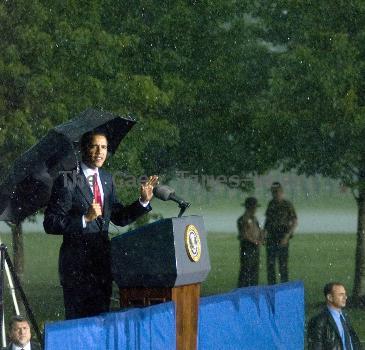Hurricane Alex drenches northern Mexico as it pushes inland; largely spares nearby Texas
By Christopher Sherman, APThursday, July 1, 2010
Hurricane Alex drenches Mexico’s northern coast
SAN FERNANDO, Mexico — Hurricane Alex ripped off roofs, caused severe flooding and forced thousands of people to flee coastal fishing villages before weakening to a tropical storm over northern Mexico.
The Atlantic season’s first hurricane largely spared nearby Texas, which had prepared for a possible direct hit. While it brought rain, spawned two tornadoes and caused 1,000 people to evacuate low-lying areas there, state officials reported no injuries or major damage.
Earlier, Alex whipped up high waves that frustrated oil-spill cleanup efforts on the other side of the Gulf of Mexico and delivered tar balls and globs of crude onto already soiled beaches.
The storm made landfall Wednesday night on a sparsely populated stretch of coast in Mexico’s Tamaulipas state, about 110 miles (180 kilometers) south of Brownsville, Texas, and Matamoros.
Much of Matamoros was flooded Thursday morning, said Saul Hernandez Bautista, the city’s director of the Civil Protection. He said at least 400 neighborhoods were flooded, some with 12 inches (30 centimeters) of water and at least 2,500 people were in shelters, mostly people evacuated from lowing lying regions outside the city.
Trees were uprooted and electrical posts were down. Hernandez said there were no known injuries or deaths in the Matamoros area but he did not know about the area farther south where the eye of the storm hit.
“The damages are incalculable. The city is practically under water,” Hernandez said. “But the most important thing is that there was no loss of life. We took important and opportune measures to evacuate people.”
The U.S. National Hurricane Center said Alex was pushing inland early Thursday at 12 mph (19 kph) but had weakened to a a tropical storm with sustained winds of 70 mph (110 kph). It was expected to and dissipate within 24 to 36 hours.
By 7 a.m. CDT (1200 GMT), it was located about 55 miles (85 kilometers) west of Ciudad Victoria, and had sustained winds of 70 mph (110 kph).
The center said that as winds lessened, the major problem was likely to become heavy rainfall.
To the west of Tamaulipas, Nuevo Leon state Gov. Rodrigo Medina de la Cruz told the Televisa television network that the approaching storm had already dumped 16 inches (40 centimeters) of rain in some areas. He ordered all schools closed and appealed for people to stay home from all but essential jobs. Medina said at least 2,300 people had been evacuated.
Alex had heavy rains and winds topping 110 mph (160 kph) as it hit land, lashing Mexican fishing villages, whose residents fled inland to the town of San Fernando on buses and in pickup trucks. Hundreds of people filled a storm shelter in a town auditorium.
“We didn’t bring anything but these clothes,” said evacuee Carolina Sanchez, 21, motioning to two small plastic bags at her feet, as her 3-year-old sister Belen Sanchez Gonzalez clutched a purple and white stuffed toy poodle at the storm shelter.
Her father, a fisherman, was one of many coastal residents who stayed behind to keep watch on their homes and possessions.
Abel Ramirez of San Fernando’s Civil Protection and Fire Department said seven fishing villages, with a combined population of about 5,000, were evacuated.
The storm blew down trees and lifted the tin roofs off several homes.
In Texas, officials closed the causeway to South Padre Island, a vacation getaway off the coast, and 9-foot (3-meter) waves were reported on the island’s beach.
More than 1,000 people in low-lying Hidalgo and Cameron counties fled to storm shelters and more than 1,000 homes were without power late Wednesday, though the biggest outage was caused not by the storm but by a car that ran into a utility pole, American Electric Power spokesman Andy Heines said.
The main threat as the hurricane begins to fall apart over land will be tornadoes, which could last another day or two, hurricane center meteorologist Chris Landsea said.
The other big threat is rain, Landsea said. Parts of Mexico and Texas are expected to get 6-12 inches (15-30 centimeters) of rain, which could cause flash flooding, he said.
It was the first June hurricane in the Atlantic since 1995, according to the hurricane center.
Flash floods also forced hundreds of evacuations in the southern Mexican states of Oaxaca and Guerrero, but hurricane specialist Eric Blake said those rains were only indirectly related to Alex and possibly the residual effects of Hurricane Darby, which has dissipated in the Pacific.
Three people — a couple and their 5-year-old child — were killed when heavy rains and winds brought down a wall on their wooden house in Acapulco, state Civil Protection authorities said.
Oil rigs and platforms in the path of the storm’s outer bands were evacuated, and President Barack Obama issued a pre-emptive federal disaster declaration for southern Texas counties late Tuesday.
The three oil rigs and 28 platforms evacuated are not part of the Gulf oil spill response.
The storm was far from the Gulf oil spill, but cleanup vessels were sidelined by the hurricane’s ripple effects. Six-foot waves churned up by the hurricane splattered beaches in Louisiana, Alabama and Florida with oil and tar balls.
In Louisiana, the storm pushed an oil patch toward Grand Isle and uninhabited Elmer’s Island, dumping tar balls as big as apples on the beach. Boom lining the beach had been tossed about, and it couldn’t be put back in place until the weather cleared.
“The sad thing is that it’s been about three weeks since we had any big oil come in here,” marine science technician Michael Malone said. “With this weather, we lost all the progress we made.”
Associated Press Writers Paul J. Weber in Brownsville, Texas and Mary Foster and Tom Breen in Grand Isle, Louisiana, contributed to this report.
Tags: Accidents, Barack Obama, Brownsville, Central America, Coastlines And Beaches, Emergency Management, Floods, Latin America And Caribbean, Louisiana, Mexico, North America, San Fernando, Storms, Texas, Tropical-weather, United States












